









Attractions
| Cape Town & Surrounds |
|
Table Mountain
Since it's opening in 1929, over 16 million people have taken the trip to the top of Table Mountain. The Table Mountain cableway has since become something of a landmark in Cape Town, and has carried some of Cape Town's most illustrious visitors A visit to Cape Town would be incomplete without a trip up the famous Table Mountain which reaches a height of 1085m at its highest point and had a broad flat surface allowing it to appear as a 'table' from certain angles, inspiring its name. The glorious views over the Mother City starts the minute you step into the state of the art cableway (one of only three in the world). The floor of the 65 passenger cablecar rotates 360 degrees on the ascent/descent which takes 5-10 minutes to reach the summit/base travelling at a speed of up to 10m per second. Undeniably the best views over the Cape are to be taken in from this natural landmark mountain which allows all parts of Cape Town to be seen at once in all magnificence. The mountain itself serves as a nature reserve home to many indigenous plants and animals. On the top there are a selection of viewpoints over the peninsula and the paths suitable for all ranges of the explorer from the handicapped to the avid hiker, maps are available on site. There is a curio shop and full cafe for refreshments and meals on the top. The weather can change without notice so be sure to have sunscreen and hats as well as warm clothing and of course remember to take your camera. Address: Lower Cable Station, Tafelberg Rd, Cape Town, 8001. |
|
You can easily visit the Signal Hill look-out every afternoon and not get tired of it. Each day is an experience of its own! Remember to pack a picnic basket and blanket so that you can enjoy a sundowner while watching a perfect sunset over the ocean. After dark, the hill is a popular scene for couples wanting to enjoy the romantic sights of the sparkling city lights set against the backdrop of a floodlit Table Mountain. |
|
Situated in the heart of Cape Town's working harbour, the Victoria & Alfred Waterfront has become South Africa's most visited destination. Set against a backdrop of magnificent sea and mountain views, exciting shopping and entertainment venues are intermingled with imaginative office locations, world-class hotels and luxury apartments in the residential marina. We invite you to discover the experience... live, work, shop and play at the V&A Waterfront. |
|
Two Oceans Aquarium, Cape Town
The Two Oceans Aquarium is without doubt one of the most exciting attractions in the city, particularly if you have children (there is a wonderful child play area in the basement set right up against the seal display where children and seals have fun alongside one another). Child-height window benches and a ‘touch pool’ where they can touch and feels kelp, shells and anemones add to the appeal. Exhibits include: The Oceans of Contrast; Indian Ocean gallery that is actually a collection of six exhibits showcasing life in the warmer ocean. |
|
Helicopter Flip over Cape Town (V&A Waterfront)
|
|
The stunning beauty of the Island betrays her dark past and your visit to Cape Town will be all the richer for experiencing what Mr. Mandela endured to make South Africa the free, open and friendly country we all enjoy today, you don’t want to miss this Daily tours to the island include the ferry trip there and back, an island tour and a tour of the prison with a fomer political prisoner as your guide. Allow three and a half hours for the trip (this includes the 1/2 hour ferry trip each way) and book in advance. Ferries leave at regular intervals throughout the day from the Clock Tower precint at the V&A Waterfront. |
|
Boasting state-of-the-art Las Vegas-style gaming coupled with world-class entertainment, Grand West transports you to a place of unlimited possibility, fantasy and variety. Steeped in grandeur, rich in history and warm with the generous spirit of the Cape, Grand West reigns supreme as the destination your wildest dreams are made of. |
|
Telephone: 0861 200 300 |
|
A visit is worthwhile if only for the panoramic views - at the same time stop for breakfast, lunch or afternoon tea at the popular outdoor tea-room. |
|
Kirstenbosch Botanical Garden, Cape Town
|
|
Chapman’s Peak Drive also offers superb hiking experiences up the peak, through Silvermine Nature Reserve and Cape Peninsula National Park and some unlikely whale watching spots. At the other end of the drive lies the village of Noordhoek and the neighbouring suburbs of Kommetjie, Scarborough and Fish Hoek |
|
|
|
Wooden walkways allow visitors to view the penguins in their natural habitat and there is also a new information centre. Children will love the penguins and their antics and Boulders Beach is also worth a stop for safe and enjoyable swimming. |
| Beaches |
|
Table Bay Beaches, Western Cape
Bloubergstrand has some lovely rock pools and the viewpoint from here of the bay and Table Mountain has graced many a postcard. Table View has a number of restaurants and venues for sundowners and Dolphin beach is the first of this series of beaches reached from the M14 and is synonymous with kitesurfing. Milnerton is well known for its lighthouse, which sits virtually on the beach and is great for swimming as, unlike Dolphin beach, it is manned by lifeguards |
|
Atlantic Seaboard Beaches, Western Cape
Clifton is an extremely popular hangout for locals and international jet setters - you’re here to be seen and to share space with the latest designer costumes and sunglasses. Clifton has four beaches called 1st, 2nd, 3rd and 4th beach and has blue flag status, not least because of the turquoise water and white sands. These beaches are Cape Town’s premier beaches, divided by granite boulders and packed with beautiful people in summer. Camps Bay just up the road from Clifton, is a long, sandy beach with palm trees and a fantastic promenade lined with trendy restaurants, cafes and cocktail bars. Here Cape Town's fashionable set mingle with visitors to the city against one of the most beautiful backdrops of Lion’s Head and the 12 Apostles. The beach is very popular for sundowners and in hot weather it’s a beach paradise. From Camps Bay you can walk to Glen Beach - a small beach set in a little enclave and great for surfing - and Maiden’s Cove, which is very much a family beach just in front of the Glen Country Club. Bakoven Beach gets a mention because of its natural beauty - big boulders, white sands and a gorgeous setting. But it’s smallish and zealously protected by territorial local residents. Llandudno, set in an exclusive neighbourhood, is one of the most photogenic beaches in Cape Town and definitely one of the most beautiful. If you’re not a strong swimmer then settle for a dip as the currents are strong but great for surfers and sunsets here are notorious. Parking can be a bit of a headache but this does mean it doesn’t get too crowded. Sandy Bay, a bit of a clamber across the boulders from Llandudno or a walk from the car park, is enclosed by sand dunes and well protected from the wind. It’s Cape Town’s nudist beach and not as busy as the other beaches, possibly because of the walk. But you can escape the crowds here and don’t have to be naked in order to experience the beach. Hout Bay is a protected harbour bay great for walks and horse riding with spectacular mountain surrounds and views over the Hottentots Holland Mountains in the distance. The Chapman’s Peak side of the beach is better for sunbathing and swimming is good here as the waves are gentle. Hout Bay beach consists of a large stretch of powder white sand with a gentle river running through the middle. Fish and chips are the order of the day and a stroll along the pier to view the fishing boats is a treat, particularly if you can spot the odd Cape Fur seal or whale, during season. Hout Bay's beauty is unforgettable and is surrounded by an amphitheatre of mountains that seem to majestically guard over its calm indigo bay. |
|
South Atlantic Beaches, Western Cape
Noordhoek Beach, at the end of Chapman’s Peak drive and south of Hout Bay, has a gorgeous, incredibly wide expanse of sand perfect for long walks, horse riding and local surfers. Views of the bay are spectacular and the beach is lined with dunes that offer shelter from the wind. The beach borders on local wetlands and because of its size, is rather isolated so swimming or walking on your own are probably not a good idea. Long Beach at Kommetjie is just that, a long, sandy beach very popular with surfers. There is also a large tidal pool here great for swimming and families with some spectacular views. Witsands, between Kommetjie and Scarborough, is popular with surfers, windsurfers and kitesurfers alike. For locals, this is a haven as it’s further from Cape Town and thus not very well known. The beach is big and there are plenty of sand dunes, which contribute to the beauty of the natural surrounds. Misty Cliffs, situated below a conservation village of the same name, is wonderfully remote with some of the most awe-inspiring views of the Atlantic. Waves here can get notoriously big, so it isn’t really a swimmers paradise and even surfers take along an extra fin. It is popular with locals, divers and those wanting to escape it all. Scarborough Beach is large with plenty of sand for sunbathing, popular with surfers and body boarders and has some beautiful views. Because it’s so far from Cape Town (it's the last residential suburb before Cape Point), it never gets crowded here although it can get busy in summer. When the wind blows, it’s an ideal spot for flying kites and kitesurfing. |
|
False Bay Beaches, Western Cape
St James Beach is not very wide or big and it can get rather crowded in summer, but it offers a delightful tidal pool which is great for children. During high tide big waves can break against the tidal pool wall. A similar tidal pool can be found in Kalk Bay (Dalebrook Pool), just a little further down the main road. Danger Bay Beach, nearby, is much quieter and tends to be used by local residents. Fish Hoek beach is very popular with pensioners and families and its calm waters offer plenty of space for games, swimming, walking and exploring. The walkway that hugs the right hand side of the beach makes an enjoyable Sunday afternoon stroll and is a good place for spotting whales that come right into the bay during season. Clovelly Beach adjoins Fish Hoek beach on the far left hand corner of the beach and tends to be used by young surfers. Glencairn beach is great for swimming and sunbathing or for spotting great whites, which shouldn’t deter you from the waters as there is more chance of being killed by a falling coconut in Thailand than by a shark in South Africa! |
|
Cape Helderberg Beaches, Western Cape
Strand has a long 5km stretch of white, sandy beach ideal for long walks. Fishing and surfing and wind surfing are very popular here as the waves are quite good. There is also an Olympic sized, centrally heated swimming pool at Strand. Gordon’s Bay, regarded as one of the safest swimming beaches, has wonderful sheltered rock pools great for exploring and paddling. |
|
Langbaai Beach, which is located between two rocky outcrops, and has limited parking is a more private and secluded beach suitable for long lazy days spent soaking up the sun. It offers excellent swimming and is clean and well maintained. Grotto beach is another local beach that offers excellent facilities in the form of a restaurant play park and well maintained ablution facilities. A favourite with locals and tourists alike, endless stretch of white sand also makes it an excellent location to take the dogs for a walk, something which many a pet owner can be seen taking advantage of. In fact, many of the beaches in Hermanus allow pets and making Hermanus a great choice for families who can’t bear to leave their four legged friends behind. Kammabaai is another beach with shallow water, ample parking and excellent facilities; making it ideal for family outings, especially for those with small children. The beach at Voelklip, flanked by green lawns, and with good facilities, is especially popular with younger adults during the peak tourist season. With refreshments on hand, and being another prime surfing spot, the beach is sometimes very full during season and may not always appeal to those who are looking for a more quiet, sedate beach experience. |
| Day Drives |
|
Feast on Seafood at Die Strandloper (Langebaan) Just 125km up the Cape West Coast you will find Die Strandloper, an open air, very casual restaurant with sand underfoot, blue skies above, and at the water's edge, a magnificient view of Langebaan Lagoon. To the accompaniment of live traditional guitar music, meals are served in individual courses extending over a leisurely three to four hour period. The central focus is an open braai area where everything from black mussels in wine to "really strong" coffeee takes its turn. Traditional treats include, paella potjie rich in calamari, angel fish and snoek, grilled haarders, smoked angel fish, snoek with sweet or steamed potato, plus waterblommertjie bredie. |
|
Thousands of seabirds roost on sheltered islands, pristine golden beaches stretch endlessly into the early morning mist and brooding salt marshes are home to vast concentrations of migrant waders from the northern hemisphere. During the spring the strandveld is embroidered with a tapestry of multi-hued flowers, while in the Postberg section many antelope are to be seen in a setting that is as unique as it is idyllic. |
|
The old Tolhuis in the Michells Pass was the pay point for drive through travellers to the diamond fields. There are a number of arts and crafts shops in the district and visitors will be treated to some of the local homemade treats, such as jams, chutneys, liqueurs, etc. Ceres is also home to the largest model car collection in South Africa. Art lovers can indulge themselves in local arts or simply have a picture framed. Mainly deciduous fruit is farmed. The town has shown rapid growth in industry and business development in the past years. Snow is very common in this area during the winter months. |
|
The entire Cape Overberg coastline offers generous sightings of the whales and the Walker Bay area, between Gansbaai and Hermanus, is a whale sanctuary. Hermanus arguably offers the best land-based whale watching in the world. For this position it competes only with Plettenberg Bay, further along the coast. Not only does Hermanus boast the world’s only ‘whale crier’, but there is a 14 km cliff path that offers a bird’s eye view of the 100 or so Southern Right Whales that visit Walker Bay every year and often come within five to ten metres of the coast. Hermanus celebrates the arrival of the whales with an event-filled annual Whale Festival in late September |
|
The lighthouse at Danger Point is open to tourists, and you can climb the stairs to the revolving light and peer out at the restless waters that cover the remains of the famous Birkenhead wreck. Whether you come to Gansbaai to fish, dive, ecotour, or simply to experience the beauty of the great outdoors, you can enjoy the opportunity to visit our unique and interesting communities during your vacation. |
|
This coastline is extremely ominous and many ships have floundered here. This region also lays claim to a National Park which has more than 8500 species of flowering plants and a bounty of birds in the wetlands. L'Agulhas has several hiking trails. There are also two tidal pools and two rock pools for swimming. |
| Wine Routes |
|
Each cellar presents a unique experience. Some boasts beautiful historic homesteads and others brand new modern tasting rooms, while smaller wineries offer intimate wine tasting in rustic cellars or outside amongst the vineyards. Olives is an integral part of the agricultural products of the region and some wineries offer a variety of olive produce for sale. |
|
Breedekloof Wine Route, Breede River Valley
Wine in this region was initially produced by co-operative cellars that focused primarily on producing sweet wines in bulk. Today individual wine growers create award winning red, dry white and sweet wine varieties and there are some 23 cellars to visit and scenery to take your breath away. |
|
Cape Agulhas Wine Route, Western Cape
Elim is something of a phenomenon as its unique ‘terroir’ has caused much excitement in the wine community worldwide. The cool and strong winds that prevail - south westerly and south easterly - have the effect of providing a very cool ripening season, perfect for Sauvignon Blanc and promising for Semillon and Shiraz. But more than that, this aspect, together with other climatic factors, results in the vineyards here developing unique explosive flavours that have not been tasted before, even by seasoned connoisseurs. |
|
Cape Point Wine Route, Cape Wine Routes
At the moment there are 30 hectares under vine on the Noordhoek and Scarborough sites with Sauvignon Blanc and Semillon as their main focus although a recent planting at Red Hill, bordering the Cape Point Nature Reserve, means that the first red wine vineyards have joined the stable. These promising vineyards, some of them a mere kilometre from the sea, are situated on the western edges of the Cape Peninsula. This cool-climate district is recognised for its Sauvignon Blanc and Semillon. Now the first red wine vineyards, planted at Red Hill bordering the Cape Point Nature Reserve, have come on stream. |
|
Constantia Wine Route, Cape Town
The Constantia valley, just 20 minutes outside of Cape Town’s city bowl, is breathtakingly beautiful, with vineyard rows that stretch up the eastern slopes of the Constantiaberg mountainside. The route is an easy morning or day trip and the farms provide quality restaurants for lunches and tea. Rich in heritage and beauty, Constantia Wine Route is made up of three famous wine estates, namely Buitenverwachting, Groot Constantia and Klein Constantia. Constantia was one of the first wine-producing areas of the Western Cape. |
|
Darling Wine Route, Western Cape
The Cape West Coast has recently been recognised as a viticultural region with great potential and is undoubtedly one of the most beautiful areas in South Africa. Darling is only an hour’s drive from Cape Town and one can visit the cellars easily within a day’s trip. If you’re in a hurry, the Vyge valley farmstall, on Route 27, stocks some of the local wines at cellar prices. |
|
Franschhoek Wine Route, Cape Winelands
The Valley of the Huguenots, as Franschhoek is also known, became home to a community of French Huguenots who fled their country from religious persecution. They soon recognised that this valley had very similar weather to the wine growing regions in France. Today, over 300 years later, this tradition continues and the valley produces all the classic styles and noble cultivars - from whites such as Sauvignon Blanc, Semillon and Chenin Blanc through to the reds of Cabernet Sauvignon, Shiraz, Merlot and Pinot Noir. Over 30 wine cellars produce some of the country’s top wines. The valley has just launched a Cap Classique route that includes nine cellars, within a distance of 4 km, in a combined marketing initiative. The sparkling wine tour includes teaching visitors about the methods of making Cap Classique in a unique attempt to add value to wine consumption. The long restaurant row on Huguenot Street in Franschhoek list Franschhoek wines on their menus. |
|
Helderberg Wine Route, Cape Wine Routes
The 25 members of the Helderberg route follow distinctly different methods of growing grapes, from a 300-year old historical cellar to state-of-the-art boutique wineries and visiting the wide range of family-owned estates and grand manor houses is a superb weekend or day’s outing. Helderberg wineries include Vergelegen, Ken Forrester Wines at Scholtzenhof Vineyards, Morgenster Estate, Post House Cellar and many others. |
|
Stellenbosch Wine Route, Cape Winelands
Bottelary Hills lies on the slopes of the Bottelary Mountain range with most of its vineyards facing north thus producing excellent red wines. This area is considered at the forefront of viticulture and viniculture when it comes to Pinotage. Devon Valley Vintners lies to the west of Stellenbosch. Most of the wineries are small and focus on red wines although they have also produced some enviable premium white and sparkling wines. Simonsberg-Stellenbosch is known as ‘Cabernet country’. The town of Stellenbosch, which lies at the heart of this winemaking area, is a gorgeous, historical university town with some of the best-preserved Victorian and Georgian buildings along Dorp Street, itself a national monument. Its oak-lined streets are home to a number of excellent restaurants, coffee shops, boutiques and galleries. The university is the only one in South Africa with a viticultural and oenological department and Stellenbosch is home to one of the most modern experimental wineries in the world. |
| Neighbouring Countries Highlights |
| Namibia |
|
It is approximately 180kms long and stretches south from Seeheim down to the Orange river which forms the border between Namibia and South Africa. The trail itself, follows 90kms of this amazing wonder of nature, from the view site at Hobas to finish at the hot water spa resort of Ai-Ais. The canyon is the habitat of some small hardy mammals such as rock-hopping Klipspringer Antelope, little Dassies (rock hyrax) and Baboons. There are also Kudu, Leopard and Mountain Zebra, whose spoor you might come across, but are unlikely to see. Birdlife is more prolific with well over 60 species such as Herons, hammerkops, Egyptian Geese, Plovers and Wagtails. In an area plagued by drought, the Fish River was an oasis to early inhabitants of the region. The sights are so incredible that your camera can hardly do justice to its natural magnificence. |
|
The Skeleton Coast Park extends nearly 500 km to the Ugab River in the south to the Kunene in the north and covers an area of around 16,000 sq.km. It is a remote area often covered in a blanket of coastal fog or suffering from cold sea breezes. The landscape of the Skeleton Coast ranges from huge sand dunes to deep canyons and mountain ranges, whose slopes are covered by a variety of plants which have adapted to the environment, such as the peculiar elephant foot plant. |
|
|
|
One of Africa' greatest and most important game parks, Etosha covers an area of more that 22 000 square kilometres. The area is a mixture of dense bush, open plains and the incredible salt pans for which Etosha is best known. The heart of the park is the amazing, shimmering Etosha Pan. This shallow depression fills up in the rainy season and forms a magnet for waterfowl, as well as an incredible diversity of game - Elephant, Giraffe, Lion, Eland and many more. The dry season also presents fantastic game viewing opportunities as the animals congregate around the waterholes. Large herds of plains game crowd the waterholes to drink and apart from the animals mentioned above, one can expect to find Leopard, cheetah, oryx, kudu and wildebeest. |
| Botswana |
|
Sometimes called a 'swamp', the Okavango is anything but. Moving, mysterious, placid, gentle and beautiful, from a wide and winding channel it spreads through tiny, almost unnoticeable channels that creep away behind a wall of papyrus reed, into an ever expanding network of increasingly smaller passages. |
|
A major feature of Chobe National Park is its elephant population currently estimated at around 120,000. The Chobe elephant are migratory, making seasonal movements of up to 200 km from the Chobe and Linyanti rivers, where they concentrate in the dry season, to the pans in the southeast of the park, to which they disperse in the rains. |
| Zimbabwe |
|
Most of all, of Kariba, you will remember the smells of Africa. The dust of the day, the moisture of the lake and, most evocative of all, the smell of advancing rain. At any time of the year Lake Kariba offers entertainment, relaxation, sport and adventure. There is something at Kariba for everybody – and all of it unforgettable. |
|
The famous bridge straddling the mighty Zambezi at the Victoria Falls provides easy access between the two neighbouring countries of Zambia and Zimbabwe. |
|
The park is situated on the main road between Bulawayo and the world famous Victoria Falls. All Zimbabwe's specially protected animals are to be found in Hwange and it is the only protected area where gemsbok and brown hyena occur in reasonable numbers. The population of wild dog to be found in Hwange is thought to be of one of the largest surviving groups in Africa today. |
|
The two main areas of stone wall enclosures are the Hill Complex, on the long, steep-sided granite hill and the land below this hill where the Valley Enclosures and the Great Enclosure are situated. |
| Mozambique |
|
The Bazaruto Archipelago is on the spectacular southern coast and also is a national park and number one destination in Moambique. The main islands making up the archipelago are Santa Carolina, Bazaruto, Benguerra and Magaruque. |
|
It is a sleepy historic town known for its rusting colonial architecture and has been popular with tourists in recent years. The settlement owes its existence to a deep inlet into which the small river the Matamba flows. Two protective sandy headlands protect the harbor and form a sandbank. |
|
This huge wilderness preserve, covering 42 000 square kilometers, is only just being discovered and contains by far the greatest concentration of wildlife in Mozambique. Niassa National Reserve is truly a Mozambique wildlife paradise, providing refuge for over 200 endangered Cape Hunting Dog (African Wild Dog), as well as other predators such as lion, leopard and Spotted Hyena, and general game such as kudu, bushbuck, impala, wildebeest, waterbuck, reedbuck and hippo. Three sub-species, the Niassa Wildebeest, Boehm's Zebra and Johnston's Impala are endemic to the Niassa area. This is one of the last areas in the world where such a wide array of wildlife thrives without any management by man. |
|
Gentler pursuits in Ponto do Ouro include whale- and dolphin-watching trips (you can even swim with the dolphins), viewing turtles (who lay their eggs on the beach in the summer months), swimming, and long beach walks. It is a beautiful three kilometre stroll along the beach to South Africa's border at Kosi Bay. |
FOR SALE | CONTACT | TESTIMONIALS | LINKS | TERMS & CONDITIONS
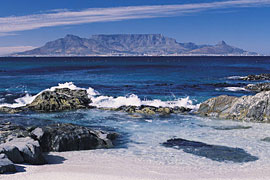 Since the first person laid eyes on Table Mountain, it has exerted its powerful and charismatic pull, enchanting and drawing any and all who fall under its spell.
Since the first person laid eyes on Table Mountain, it has exerted its powerful and charismatic pull, enchanting and drawing any and all who fall under its spell. 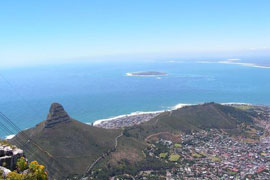 Signal Hill is the famous, flat-topped hill located in Cape Town, next to Table Mountain and Lion's Head. Signal Hill is well known for the cannon shot at noon.
Signal Hill is the famous, flat-topped hill located in Cape Town, next to Table Mountain and Lion's Head. Signal Hill is well known for the cannon shot at noon. 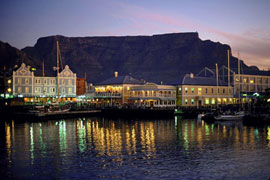 One of Cape Town's biggest tourist attractions, the Waterfront evokes images of the early activities of the harbour. Much of its charm lies in the fact that this busy commercial harbour is set in the midst of a huge entertainment venue with pubs, restaurants, specialty shops, craft markets, theatres and movies.
One of Cape Town's biggest tourist attractions, the Waterfront evokes images of the early activities of the harbour. Much of its charm lies in the fact that this busy commercial harbour is set in the midst of a huge entertainment venue with pubs, restaurants, specialty shops, craft markets, theatres and movies.  Called the Two Oceans Aquarium because the vast Indian and Atlantic Oceans meet here, or almost here at the southern tip of the continent, the delightful underwater nature reserve is based at the V&A Waterfront in Cape Town, with over 3000 living sea animals, including sharks, fish, turtles, and penguins on display.
Called the Two Oceans Aquarium because the vast Indian and Atlantic Oceans meet here, or almost here at the southern tip of the continent, the delightful underwater nature reserve is based at the V&A Waterfront in Cape Town, with over 3000 living sea animals, including sharks, fish, turtles, and penguins on display.  Address: East Pier Road, Breakwater, V&A Waterfront, Cape Town.
Address: East Pier Road, Breakwater, V&A Waterfront, Cape Town.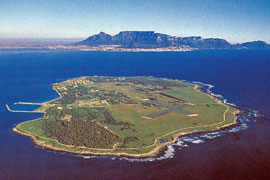 Visit the Island where Mr. Nelson Mandela spent the majority of his 27 years imprisonment with an afternoon on Robben Island.
Visit the Island where Mr. Nelson Mandela spent the majority of his 27 years imprisonment with an afternoon on Robben Island. 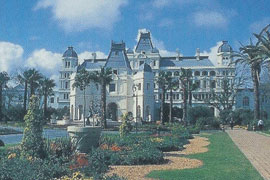 Set against a backdrop of the majestic Cape, an ornate treasure chest lies waiting to be unlocked. Sparkling with the spirit of excitement and magical adventure, Grand West Casino and Entertainment World takes centre stage as the Mother City’s premier entertainment extravaganza – offering pure pleasure and larger-than-life fun for the whole family.
Set against a backdrop of the majestic Cape, an ornate treasure chest lies waiting to be unlocked. Sparkling with the spirit of excitement and magical adventure, Grand West Casino and Entertainment World takes centre stage as the Mother City’s premier entertainment extravaganza – offering pure pleasure and larger-than-life fun for the whole family.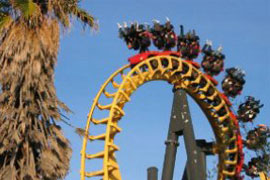 More than 30 attractions include 24 rides ranging from kiddie rides to family rides and thrill rides for the more intrepid adventurers. Train rides and boat rides add to the offer. Snake shows and bird shows, guaranteed to enthrall audiences, add spice and variety to the full day's entertainment.
More than 30 attractions include 24 rides ranging from kiddie rides to family rides and thrill rides for the more intrepid adventurers. Train rides and boat rides add to the offer. Snake shows and bird shows, guaranteed to enthrall audiences, add spice and variety to the full day's entertainment.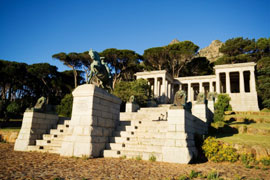
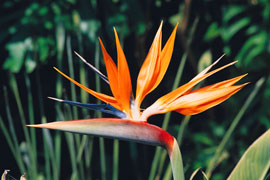 By car - Kirstenbosch lies 13 km from Cape Town city centre. From the city, take De Waal Drive (M3) in the direction of Muizenberg, at the first traffic light intersection turn right (southwards) into Rhodes Drive (M63) and follow the signs to Kirstenbosch.
By car - Kirstenbosch lies 13 km from Cape Town city centre. From the city, take De Waal Drive (M3) in the direction of Muizenberg, at the first traffic light intersection turn right (southwards) into Rhodes Drive (M63) and follow the signs to Kirstenbosch. 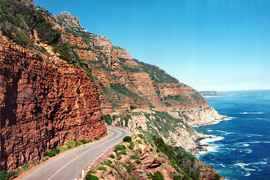 Chapman’s Peak Drive winds it way between Noordhoek and Hout Bay. Situated on the Atlantic Coast, at the south-western tip of South Africa, it is one of the most spectacular marine drives anywhere in the world. The drive offers stunning 180° views with many areas along the route where you can stop and take in the scenery or sit down for a relaxing picnic.
Chapman’s Peak Drive winds it way between Noordhoek and Hout Bay. Situated on the Atlantic Coast, at the south-western tip of South Africa, it is one of the most spectacular marine drives anywhere in the world. The drive offers stunning 180° views with many areas along the route where you can stop and take in the scenery or sit down for a relaxing picnic. 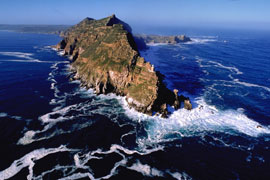 Okay, so it’s not the place where the Atlantic meets the Indian Ocean and neither is it the southernmost point of Africa. Nevertheless it is far more spectacular and a lot more accessible than the actual tip at Cape Agulhas. It's also one of the most visited attractions in Cape Town.
Okay, so it’s not the place where the Atlantic meets the Indian Ocean and neither is it the southernmost point of Africa. Nevertheless it is far more spectacular and a lot more accessible than the actual tip at Cape Agulhas. It's also one of the most visited attractions in Cape Town.  Situated near Simons Town on the false bay side of the penninsula, Boulders Penguin Colony is home to a growing colony of the vulnerable African Penguin.
Situated near Simons Town on the false bay side of the penninsula, Boulders Penguin Colony is home to a growing colony of the vulnerable African Penguin. 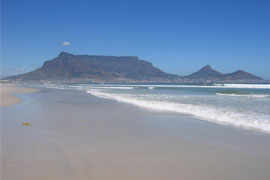 Table Bay’s beaches can be unpleasant when the wind blows but nothing beats these beaches for their view of Table Mountain and Robben Island and the miles of sand on which to stretch your legs.
Table Bay’s beaches can be unpleasant when the wind blows but nothing beats these beaches for their view of Table Mountain and Robben Island and the miles of sand on which to stretch your legs. 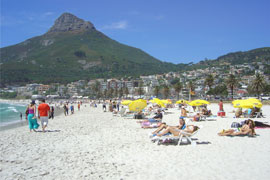 Mouille Point, Sea Point and Three Anchor Bay don’t have much beach to speak of - they’re more ocean front than beach. However, Saunders Rock at Sea Point has a little tidal pool and Three Anchor Bay has a tiny, little beach from which many sea kayakers embark. It's the promenade that draws people here. This walkway is right near the sea and is a haunt of joggers, walkers, dog walkers and families.
Mouille Point, Sea Point and Three Anchor Bay don’t have much beach to speak of - they’re more ocean front than beach. However, Saunders Rock at Sea Point has a little tidal pool and Three Anchor Bay has a tiny, little beach from which many sea kayakers embark. It's the promenade that draws people here. This walkway is right near the sea and is a haunt of joggers, walkers, dog walkers and families. 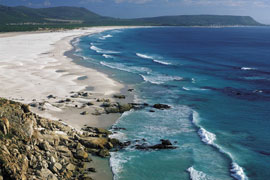 The South Atlantic, running south along the west coast from Noordhoek to the tip Cape Point at the tip of the Cape Peninsula, offers an escape from the crowds of sun worshippers who flock to the better known beaches of Clifon and Camps Bay. The beaches of the South Atlantic, though a further drive, are rugged and unspoilt and are ideal for those looking for peace and quiet and natural beauty.
The South Atlantic, running south along the west coast from Noordhoek to the tip Cape Point at the tip of the Cape Peninsula, offers an escape from the crowds of sun worshippers who flock to the better known beaches of Clifon and Camps Bay. The beaches of the South Atlantic, though a further drive, are rugged and unspoilt and are ideal for those looking for peace and quiet and natural beauty. 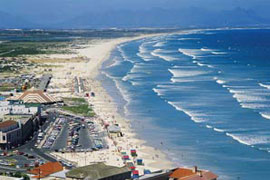 Muizenberg, very popular during its heyday in the '60s and '70s, is where every surfer learns to cut his teeth and one of the most racially integrated beaches in Cape Town. Synonymous with the colourful beach huts that make their way onto picture postcards of Cape Town, this very long beach can get pretty busy during peak season but the waves are not too powerful and there are other facilities here such as put-putt courses and water slides so that it never feels crowded.
Muizenberg, very popular during its heyday in the '60s and '70s, is where every surfer learns to cut his teeth and one of the most racially integrated beaches in Cape Town. Synonymous with the colourful beach huts that make their way onto picture postcards of Cape Town, this very long beach can get pretty busy during peak season but the waves are not too powerful and there are other facilities here such as put-putt courses and water slides so that it never feels crowded. 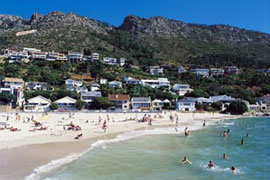 Just a 45 minute drive from Cape Town Central, the beaches of the Helderberg Basin or Cape Helderberg offer warmer waters. A visit to any of these beaches is essentially a family friendly day out that includes fantastic views over False Bay, wonderful swimming opportunities in safe and shallow waters, and rock pools ideal for children. Take a picnic, beach umbrella and don't forget the sunblock!
Just a 45 minute drive from Cape Town Central, the beaches of the Helderberg Basin or Cape Helderberg offer warmer waters. A visit to any of these beaches is essentially a family friendly day out that includes fantastic views over False Bay, wonderful swimming opportunities in safe and shallow waters, and rock pools ideal for children. Take a picnic, beach umbrella and don't forget the sunblock! 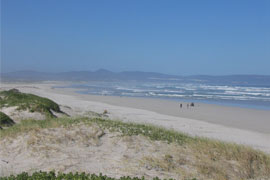 Being the whale watching capital of the Southern Hemisphere the seaside town of Hermanus in the Western Cape is undoubtedly most famous for its whales. There are, however, numerous other excellent reasons to visit this small, picturesque town.
Being the whale watching capital of the Southern Hemisphere the seaside town of Hermanus in the Western Cape is undoubtedly most famous for its whales. There are, however, numerous other excellent reasons to visit this small, picturesque town. 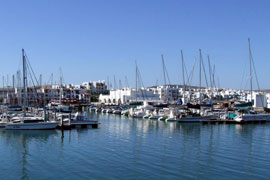 The popular town of Langebaan is just over 100 km from Cape Town on the West Coast off the R27 next to Langebaan Lagoon. The white Caribbean like beaches surrounding the crystal clear waters of the Langebaan Lagoon are one of the main attractions of Langebaan.
The popular town of Langebaan is just over 100 km from Cape Town on the West Coast off the R27 next to Langebaan Lagoon. The white Caribbean like beaches surrounding the crystal clear waters of the Langebaan Lagoon are one of the main attractions of Langebaan. 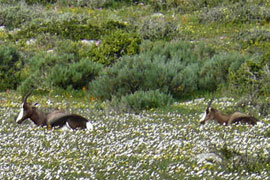 Just inland from the secluded harbour of Saldanha Bay one finds the azure waters of the Langebaan Lagoon, focal point of the West Coast National Park.
Just inland from the secluded harbour of Saldanha Bay one finds the azure waters of the Langebaan Lagoon, focal point of the West Coast National Park.  Years ago Ceres was the gateway to the diamond fields. Today the Ceres museum is home to some of these wagons and also boasts an exhibition on the wildlife species and of the apartheid years in the Ceres district.
Years ago Ceres was the gateway to the diamond fields. Today the Ceres museum is home to some of these wagons and also boasts an exhibition on the wildlife species and of the apartheid years in the Ceres district.  Catching a glimpse of the whales.
Catching a glimpse of the whales.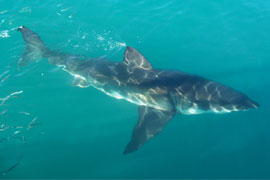 Get away from the hustle and bustle of busy city life, let down your hair, kick off your shoes and come to Gansbaai. Get back to basics with warm friendly people to welcome and pamper you. So what makes Gans Bay cool? Simply it's natural, rugged and unspoilt beauty.
Get away from the hustle and bustle of busy city life, let down your hair, kick off your shoes and come to Gansbaai. Get back to basics with warm friendly people to welcome and pamper you. So what makes Gans Bay cool? Simply it's natural, rugged and unspoilt beauty. 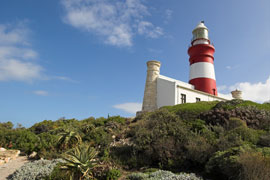 L'Agulhas is the southernmost town in Africa. Being located at the very tip of the legendary foot of Africa, it is a prime tourist destination.
L'Agulhas is the southernmost town in Africa. Being located at the very tip of the legendary foot of Africa, it is a prime tourist destination. 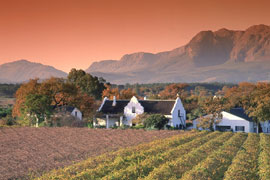 The Swartland Wine Route was established in 1986 and stretches from the Berg River in the North to the Paardeberg in the South, encompassing Piketberg, Porterville, Malmesbury and the Riebeek Valley.
The Swartland Wine Route was established in 1986 and stretches from the Berg River in the North to the Paardeberg in the South, encompassing Piketberg, Porterville, Malmesbury and the Riebeek Valley. 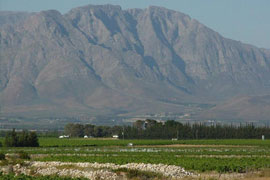 The youngest wine route in South Africa and just 90 km outside of Cape Town, the Breedekloof wine route lies in the Breede River Valley, which stretches from Gouda in the west, McGregor in the south, Montagu in the east and the Tankwa-Karoo National Park in the north.
The youngest wine route in South Africa and just 90 km outside of Cape Town, the Breedekloof wine route lies in the Breede River Valley, which stretches from Gouda in the west, McGregor in the south, Montagu in the east and the Tankwa-Karoo National Park in the north.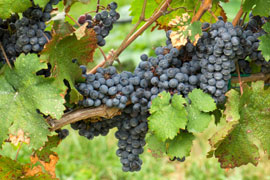 Most of the vineyards of this, the southern most point of Africa, are found in the little village of Elim. The pretty village is a national monument in its entirety and lies on a peninsular washed by two oceans - the Indian and Atlantic.
Most of the vineyards of this, the southern most point of Africa, are found in the little village of Elim. The pretty village is a national monument in its entirety and lies on a peninsular washed by two oceans - the Indian and Atlantic. 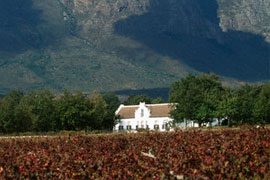 One of the very few appellations in the world just minutes outside of a city, the Constantia wine route includes five producers, each with a rich history and winemaking that dates back to late 1600s.
One of the very few appellations in the world just minutes outside of a city, the Constantia wine route includes five producers, each with a rich history and winemaking that dates back to late 1600s. 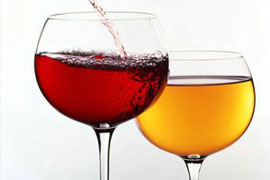 Although traditionally part of the Swartland, Darling is now a demarcated wine district and home to her own wine route, including five wine cellars all of which benefit from the cool breezes off the Atlantic Ocean and the long, hot summers to produce some stunning wines with concentrated flavour, depth and intensity.
Although traditionally part of the Swartland, Darling is now a demarcated wine district and home to her own wine route, including five wine cellars all of which benefit from the cool breezes off the Atlantic Ocean and the long, hot summers to produce some stunning wines with concentrated flavour, depth and intensity. 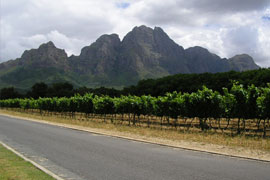 Franschhoek is just 50 minutes’ drive from Cape Town and the heart of one of the oldest and most beautiful wine routes in the Cape. Just half an hour’s drive from Stellenbosch, Paarl, Wellington and the Somerset West wine routes, Franschhoek is also part of the Four Passes Fruit Route.
Franschhoek is just 50 minutes’ drive from Cape Town and the heart of one of the oldest and most beautiful wine routes in the Cape. Just half an hour’s drive from Stellenbosch, Paarl, Wellington and the Somerset West wine routes, Franschhoek is also part of the Four Passes Fruit Route.  A sub-route of the Stellenbosch Wine Routes, the Helderberg route is only 15 minutes’ drive from Cape Town’s airport and is near the town of Somerset West. These vines lie on the slopes of the Helderberg and combine the influences of both a mountain and maritime climate, producing some very unique wines.
A sub-route of the Stellenbosch Wine Routes, the Helderberg route is only 15 minutes’ drive from Cape Town’s airport and is near the town of Somerset West. These vines lie on the slopes of the Helderberg and combine the influences of both a mountain and maritime climate, producing some very unique wines. 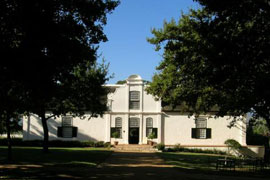 Just 45 minutes from Cape Town, the Stellenbosch wine route is the oldest in the country and represents over 300 wineries. Because of this it is divided into a number of sub-routes to make it easier to travel, namely: Bottelary Hills, Devon Valley Vintners, Helderberg and Simonsberg-Stellenbosch.
Just 45 minutes from Cape Town, the Stellenbosch wine route is the oldest in the country and represents over 300 wineries. Because of this it is divided into a number of sub-routes to make it easier to travel, namely: Bottelary Hills, Devon Valley Vintners, Helderberg and Simonsberg-Stellenbosch. 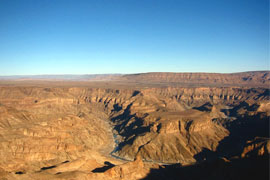 The Fish River Canyon hiking trail is unique among trails in Africa. The Canyon itself is the second largest in the world, only being surpassed by the famous Grand Canyon in Colorado.
The Fish River Canyon hiking trail is unique among trails in Africa. The Canyon itself is the second largest in the world, only being surpassed by the famous Grand Canyon in Colorado. 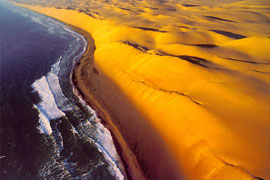 The world famous Skeleton Coast is an area of remarkable contrasts, and is named because of the skeletons of numerous ships that were wrecked here. This beautiful area is one of the main drawing cards for tourists to Namibia.
The world famous Skeleton Coast is an area of remarkable contrasts, and is named because of the skeletons of numerous ships that were wrecked here. This beautiful area is one of the main drawing cards for tourists to Namibia. 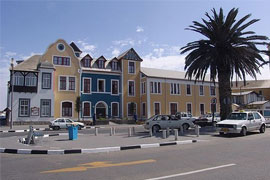 With palm-lined streets, seaside promenades and fine accommodation for all budgets, Swakopmund is Namibia’s most popular holiday destination, and its pleasant summer climate and decent beaches attract surfers, anglers and beach lovers from al over Southern Africa.
With palm-lined streets, seaside promenades and fine accommodation for all budgets, Swakopmund is Namibia’s most popular holiday destination, and its pleasant summer climate and decent beaches attract surfers, anglers and beach lovers from al over Southern Africa. 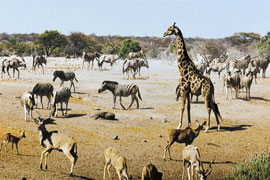 Etosha National Park, situated in Namibia, is a huge oasis in the midst of a semi-desert, providing one of the most extraordinary game viewing experiences in the region. Namibia cannot be beaten for the perfect African Safari.
Etosha National Park, situated in Namibia, is a huge oasis in the midst of a semi-desert, providing one of the most extraordinary game viewing experiences in the region. Namibia cannot be beaten for the perfect African Safari. 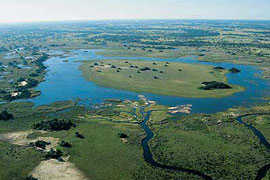 The Okavango is a labyrinth of lagoons, lakes and hidden channels covering an area of over 17,000 square km and the largest inland delta in the world. Trapped in the parched Kalahari sands it is a magnet for the wildlife who depend on the permanent waters of this unique feature.
The Okavango is a labyrinth of lagoons, lakes and hidden channels covering an area of over 17,000 square km and the largest inland delta in the world. Trapped in the parched Kalahari sands it is a magnet for the wildlife who depend on the permanent waters of this unique feature.  There are few places in the world that can equal Chobe's enormous variety of big game and bird life. Chobe National Park is located in the north of Botswana, about 80km from Victoria Falls. The Chobe National Park, is the second largest national park in Botswana. Its uniqueness in the abundance of wildlife and the true African nature of the region, offers a safari experience of a lifetime.
There are few places in the world that can equal Chobe's enormous variety of big game and bird life. Chobe National Park is located in the north of Botswana, about 80km from Victoria Falls. The Chobe National Park, is the second largest national park in Botswana. Its uniqueness in the abundance of wildlife and the true African nature of the region, offers a safari experience of a lifetime. 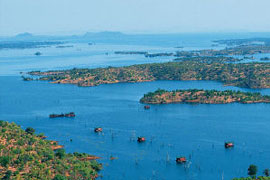 Lake Kariba, nearly 7700 square kilometers of blue water, studded with islands, fringed by mountains and forests, is a haven for the wildlife along its shores. Lake Kariba, running nearly three hundred kilometres from one end to the other, is a paradise for the discerning tourist who wants to catch a glimpse of an unspoilt Africa that has all but disappeared from the rest of the continent.
Lake Kariba, nearly 7700 square kilometers of blue water, studded with islands, fringed by mountains and forests, is a haven for the wildlife along its shores. Lake Kariba, running nearly three hundred kilometres from one end to the other, is a paradise for the discerning tourist who wants to catch a glimpse of an unspoilt Africa that has all but disappeared from the rest of the continent. 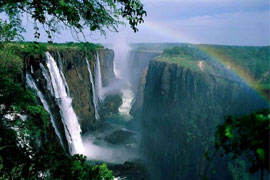 The Victoria Falls constitutes one of the most spectacular natural wonders of the world.
The Victoria Falls constitutes one of the most spectacular natural wonders of the world. 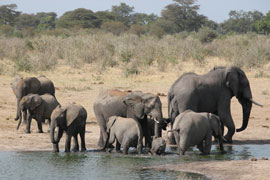 Hwange National Park is one of Africa's finest havens for wildlife and is home to vast herds of elephant, buffalo, zebra and has a very large concentration of giraffe. It is also home to many predators and endangered species plus very large and varied birdlife.
Hwange National Park is one of Africa's finest havens for wildlife and is home to vast herds of elephant, buffalo, zebra and has a very large concentration of giraffe. It is also home to many predators and endangered species plus very large and varied birdlife.  The ruins at Great Zimbabwe are remarkable; lofty, majestic, awe-inspiring, timeless. The quality of the building in places is outstanding. It was built by craftsmen who took a pride in their work. There is nothing to compare with it in southern Africa.
The ruins at Great Zimbabwe are remarkable; lofty, majestic, awe-inspiring, timeless. The quality of the building in places is outstanding. It was built by craftsmen who took a pride in their work. There is nothing to compare with it in southern Africa. 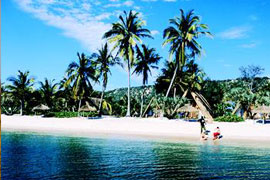 This string of idyllic islands, situated just off the coast of Mozambique, is a must for anyone planning to visit the area. With rich tropical reefs, clear warm water and isolated palm shaded beaches, it is also one of the world’s greatest fishing spots.
This string of idyllic islands, situated just off the coast of Mozambique, is a must for anyone planning to visit the area. With rich tropical reefs, clear warm water and isolated palm shaded beaches, it is also one of the world’s greatest fishing spots.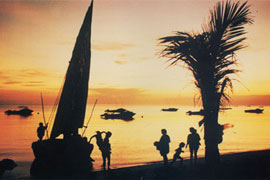 Inhambane is a photographers dream; it possesses a unique charm that can only originate from a rusty old town with delapidated buildings and neglected maintenance. It is worth exploring the fascinating mix of African, old-world Portugese and muslim cultures.
Inhambane is a photographers dream; it possesses a unique charm that can only originate from a rusty old town with delapidated buildings and neglected maintenance. It is worth exploring the fascinating mix of African, old-world Portugese and muslim cultures.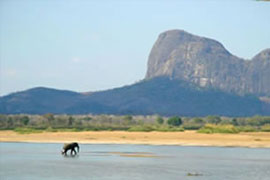 The largest conservation area in Mozambique, the Niassa Reserve covers parts of Cabo Delgado Province and nearly one third of Niassa Province and is twice the size of the world-famous Kruger National Park.
The largest conservation area in Mozambique, the Niassa Reserve covers parts of Cabo Delgado Province and nearly one third of Niassa Province and is twice the size of the world-famous Kruger National Park. 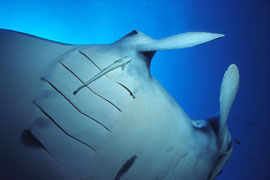 Ponto do Ouro, the southernmost point in Mozambique, is a seaside resort town popular among adventurous holiday-makers trying to get away from the crowds at Sodwana. There are many dive sites and coral reefs. Ponta do Ouro is a tourist destination to please any person interested in scuba diving, deep sea fishing, snorkelling, swimming on white sand beaches.
Ponto do Ouro, the southernmost point in Mozambique, is a seaside resort town popular among adventurous holiday-makers trying to get away from the crowds at Sodwana. There are many dive sites and coral reefs. Ponta do Ouro is a tourist destination to please any person interested in scuba diving, deep sea fishing, snorkelling, swimming on white sand beaches.